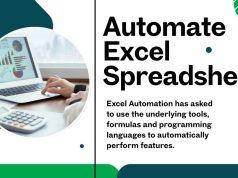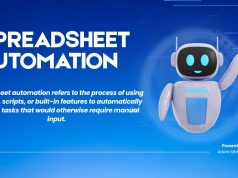The spreadsheet runs a modern workplace. From tracking budget to the administration of inventory, these digital routes handle millions of calculations daily in organizations worldwide. But here’s the problem: Most teams still do manually doing what the technology can automatically handle.
The spreadsheet changes automation how the business manages data by eliminating repetitive tasks, reducing human errors and freeing valuable time for strategic work. Whether you spend hours updating the report or struggling with data tournament, automation equipment can revolutionize your workflow.
This guide spreads the main benefits of the spreadsheet and shows you how to use real results for your business.
What Is Spreadsheet Automation?
Spreadsheet automation uses software tools and scripts to perform routine tasks without manual intervention. Instead of copying data between files, updating formulas, or generating reports by hand, automated systems handle these processes seamlessly.
Common automation examples include:
- Automatically importing data from external sources
- Generating weekly reports with updated figures
- Sending alerts when values exceed certain thresholds
- Synchronizing information across multiple spreadsheets
Modern automation tools range from simple built-in functions to sophisticated platforms that connect spreadsheets with databases, web applications, and other business systems.
Major Benefits of Spreadsheet Automation
Dramatic Time Savings
The most immediate benefit of automation is time recovery. Teams typically spend 20-40% of their workweek on manual data tasks that could be automated.
Consider these time-consuming activities:
- Copying and pasting data between files
- Manually updating monthly reports
- Cross-referencing information across multiple sheets
- Reformatting data for different stakeholders
Automation handles these tasks in seconds rather than hours. A financial analyst who previously spent three hours weekly updating budget reports can now focus that time on analysis and strategic planning.
Elimination of Human Error
Manual data entry creates opportunities for mistakes. Transposed numbers, missed cells, and formula errors can cascade through entire spreadsheets, leading to incorrect decisions.
Automated systems eliminate these risks by:
- Ensuring consistent data formatting
- Applying formulas uniformly across datasets
- Reducing copy-paste errors
- Maintaining data integrity during transfers
One misplaced decimal point in a financial model can cost thousands of dollars. Automation removes this vulnerability entirely.
Enhanced Data Accuracy and Consistency
Automation ensures data remains accurate and consistent across all systems. When information updates in one location, automated processes can instantly reflect those changes everywhere else.
This consistency proves especially valuable for:
- Financial reporting across departments
- Inventory management systems
- Customer relationship databases
- Project tracking and resource allocation
Teams spend less time reconciling conflicting data and more time acting on reliable information.
Improved Scalability
Manual processes become bottlenecks as businesses grow. Adding more data, users, or complexity to manual workflows often requires proportional increases in staff time.
Automated systems scale efficiently. Whether you’re processing 100 records or 10,000, the automation handles the workload without additional human intervention. This scalability supports business growth without corresponding increases in administrative overhead.
Better Compliance and Audit Trails
Automated processes create clear audit trails showing exactly when and how data was modified. This documentation proves invaluable for:
- Regulatory compliance requirements
- Internal audits and reviews
- Quality assurance processes
- Troubleshooting data issues
Manual processes often lack this visibility, making it difficult to track changes or identify problems after they occur.
Real-Time Data Processing
Automation enables real-time or near-real-time data updates. Instead of waiting for monthly reports or manual updates, stakeholders can access current information whenever needed.
Real-time processing benefits include:
- Faster decision-making based on current data
- Immediate alerts for critical issues
- Dynamic dashboards and visualizations
- Improved responsiveness to market changes
Types of Spreadsheet Automation
Built-in Automation Features
Modern spreadsheet applications include powerful automation capabilities:
Formulas and Functions: Advanced formulas can perform complex calculations, lookups, and data analysis automatically.
Conditional Formatting: Automatically highlights cells based on values, dates, or other criteria.
Data Validation: Prevents incorrect data entry by setting rules for acceptable inputs.
Pivot Tables: Automatically summarize and analyze large datasets without manual manipulation.
Macro Programming
Macros automate repetitive tasks by recording and replaying sequences of actions. Common macro applications include:
- Formatting reports consistently
- Performing complex calculations
- Generating charts and visualizations
- Cleaning and organizing data
While macros require some technical knowledge, they offer significant automation potential for routine tasks.
Third-Party Automation Tools
Specialized automation platforms connect spreadsheets with other business systems:
Zapier: Links spreadsheets with hundreds of web applications, automatically transferring data between systems.
Microsoft Power Automate: Integrates Excel with other Microsoft Office tools and external applications.
Google Apps Script: Provides advanced automation capabilities for Google Sheets users.
Dedicated Business Intelligence Tools: Platforms like Tableau or Power BI automatically pull data from spreadsheets to create dynamic reports and dashboards.
Implementation Strategies
Start with High-Impact, Low-Complexity Tasks
Begin automation efforts with simple, repetitive tasks that consume significant time. Examples include:
- Weekly report generation
- Data formatting and cleanup
- Basic calculations and summaries
- Email notifications based on spreadsheet values
These quick wins demonstrate automation value while building team confidence and expertise.
Identify Automation Opportunities
Audit your current spreadsheet workflows to identify automation candidates:
- Tasks performed multiple times per week
- Processes prone to human error
- Activities that delay decision-making
- Workflows that don’t require human judgment
Document these opportunities and prioritize based on potential time savings and implementation complexity.
Gradual Implementation Approach
Implement automation gradually rather than attempting to automate everything simultaneously. This approach allows teams to:
- Learn automation tools progressively
- Identify and resolve issues before they compound
- Maintain productivity during transition periods
- Build internal expertise and confidence
Training and Change Management
Successful automation requires proper training and change management:
- Provide comprehensive training on new tools and processes
- Address concerns about job security and role changes
- Establish clear procedures for maintaining automated systems
- Create documentation for troubleshooting and updates
Common Automation Challenges and Solutions

Technical Complexity
Some automation tools require technical expertise that may not exist within your organization.
Solution: Start with user-friendly tools that offer drag-and-drop interfaces and pre-built templates. Consider partnering with automation consultants for complex implementations.
Data Quality Issues
Automation amplifies existing data quality problems. Incorrect or inconsistent source data will produce flawed automated results.
Solution: Implement data validation and cleaning processes before automation. Establish clear data entry standards and regular quality checks.
System Integration Challenges
Connecting spreadsheets with other business systems can be technically challenging.
Solution: Use established integration platforms that offer pre-built connectors for common business applications. Test integrations thoroughly before full deployment.
Maintenance Requirements
Automated systems require ongoing maintenance to remain effective as business needs change.
Solution: Assign clear ownership for maintaining automated processes. Schedule regular reviews to ensure systems continue meeting business requirements.
Measuring Automation Success
Time Savings Metrics
Track time saved through automation by comparing before-and-after task completion times. Document both direct time savings and indirect benefits like improved focus on strategic work.
Error Reduction
Monitor error rates in automated processes compared to manual alternatives. Track both frequency and impact of errors to quantify improvement.
User Satisfaction
Survey team members about their experience with automated processes. Measure satisfaction with tool usability, time savings, and overall workflow improvement.
Business Impact
Connect automation benefits to broader business outcomes:
- Faster report generation enabling quicker decisions
- Improved data accuracy supporting better planning
- Reduced administrative costs through efficiency gains
- Enhanced scalability supporting business growth
Transform Your Spreadsheet Workflow Today
The spreadsheet provides convincing benefits for all sizes of organizations. From dramatic time savings to better data accuracy, automation equipment can convert regular administrative functions to strategic benefits.
The key to successful automation lies in less start, focusing on high -effect opportunities and gradually building competence in your organization. Begin by identifying the most early manual procedures and examining automation equipment that addresses these specific requirements.
Consider serving a pilot automation project with a small team or a single process. This approach allows you to show value, learn from experience and create speed for wide automation initiatives.
Remember that automation is not about changing human decisions, but about freeing people to focus on work, which requires creativity, analysis and strategic thinking. By automating regular tasks, your team can dedicate more time to activities that run real business value.










